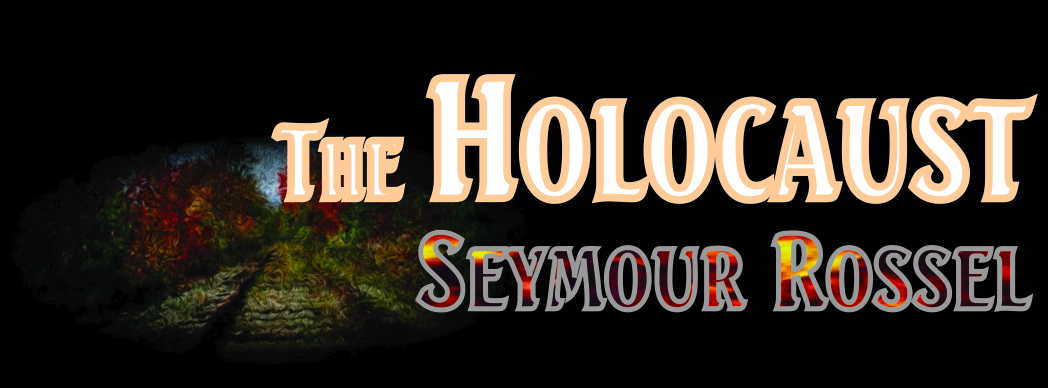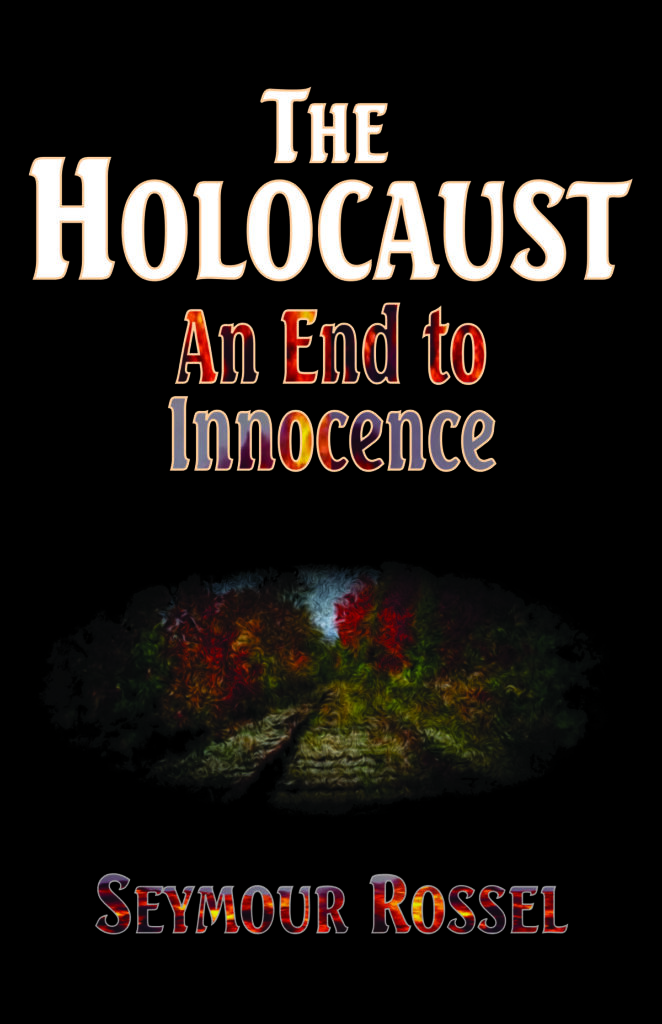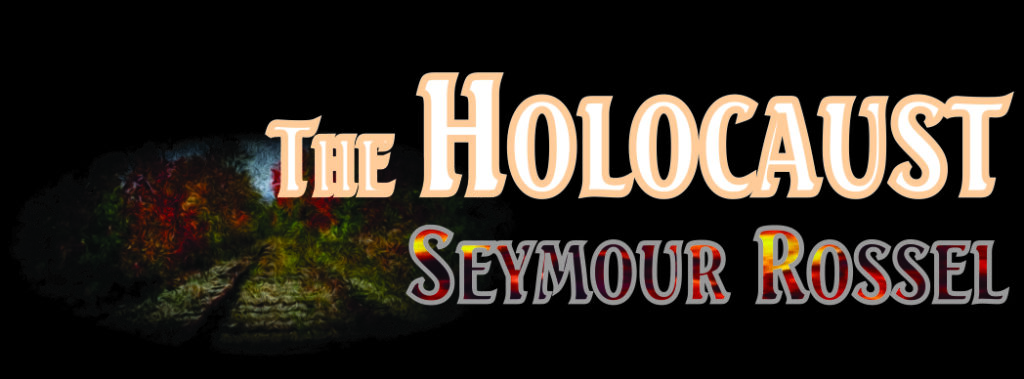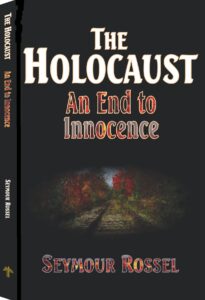The Holocaust: An End to Innocence
Paperback, 160 pages, $9.95
ISBN-10: 0940646471
ISBN-13: 978-0940646476
Kimdle/eBook, $5.99

The Holocaust:
An End to Innocence
Seymour Rossel
• How did it happen? •
• Why did we allow it to happen? •
• Could it happen again? •
These are the three questions most often asked about the Holocaust, the whirlwind of murder that resulted in the slaughter of 6 million Jews along with millions of victims from other targeted populations—Gypsies, Slavs, the mentally retarded, the insane, homosexuals, and the physically deformed.
Rossel examines the Nazi rise to power, the role of prejudice and propaganda in the Holocaust, and echoes of the Holocaust that plagued the world before, during, and after the Nazi period—and continue to plague us to this day. The Holocaust, he maintains, did not happen to the Jews alone. It is a tragedy that exposed the depths of evil we human beings are capable of visiting upon one another.
Yet, the book is not without hope. Understanding the Holocaust enables us to recognize when blowing winds of prejudice threaten to become tornadoes and hurricanes to sweep away the innocent. For, as Rossel states in the Foreword, every echo of the Holocaust offers us “the opportunity to rise above the worst that is in us and to exercise the best that is in us.”
Read a sample chapter …
Paperback Edition

Kindle Edition


The Holocaust: An End to Innocence
Sample Chapter
THE LADDER OF PREJUDICE
By the fall of 1938 the first phase of Hitler’s campaign against the Jews had been completed. The Jews were isolated and trapped. Anti-Semitism and Nazism had been linked together and identified as Germany’s path to greatness and conquest. Scholars point out that such violent anti-Semitism did not come about by accident. Minor forms of prejudice have a way of growing into destructive forms.
In his book, The Nature of Prejudice, Gordon W. Allport describes a kind of ladder of “negative actions” that spring from prejudice. It is interesting to compare how the ladder of prejudice worked in the past and how it works today. And it is possible to see parallels in history that help to explain or clarify what happened in Nazi Germany.
Speech
The first rung on the ladder of negative actions is speech. This often takes the form of talking or joking about a group as if all the members of that group were of one personality or had one set of features. One Holocaust historian, Raul Hilberg, states that “anti-Jewish racism had its beginning in the second half of the seventeenth century, when the ‘Jewish caricature’ first appeared in cartoons.” The caricature, or stereotype, was usually an exaggerated drawing of a face with a long, hooked nose; heavy, dark eyebrows; a beard that came to a sinister point; and a protruding mole. This devilish-looking character was not supposed to look like a particular Jew, but like all Jews. The Nazis used this cartoon figure again and again in posters and artwork. Speaking, they referred to the Jews as “a disease,” or as “lice.” This was a generalization that harked back to the sixteenth century when Martin Luther, the church reformer, had spoken of the Jews as “a plague,” and a “pestilence.”
The technique of creating a stereotype is one that continues. It consists in giving an entire group a single, oversimplified image. For example:
It is necessary for every White Racist to recognize the fact that the White Race does have enemies. We White racists must do that which is necessary to defeat the enemies of our Race. Certainly, the negro is an enemy with his crime, his violence, and his high birthrate. Even in a more devastating way, the negro is a biological enemy and that is true of every negro who is able to breed. That is true because every drop of negro blood pollutes the White blood. The [child] of interbreeding between a White person and a negro, or part negro, is never White. … That is why we must have a complete separation of the races so that the White race can live. [J. B. Stoner, “The Philosophy of White Racism,” The Thunderbolt, October 1973]
In this racist article all blacks are stereotyped as being alike: all are criminals, all are violent, and all have many children. Obviously this is untrue. Furthermore, the accusation that black blood is somehow able to “pollute” white blood is false, since it has been shown that all blood types occur in all races. Yet thousands of people around the world read publications like The Thunderbolt that are filled with such misinformation — and they believe them.
Avoidance
The second rung of the ladder of prejudice is avoidance. At this level people seek to avoid the group that has been stereotyped. Like speech, this seems harmless at the beginning. One has a right to choose one’s friends, and choosing not to be friends with a particular group of people does not seem so awful. The trouble is, lack of contact and friendship with a group leads to ignorance about them. And the more ignorant we are, the more we begin to believe in the stereotype.
Discrimination
Avoidance leads to the third rung, discrimination. The unwanted group is now kept out of some neighborhoods, shopping areas, social clubs, gathering places, and public centers. The laws enacted against the Jews of Germany from 1933 to 1938 were discriminatory — they were meant to separate the Jews from the rest of the German population. Discrimination can be as simple a matter as excluding Jews or blacks or Orientals from a fraternity or sorority or a social clique. Or it can be an attempt to cut an unwanted group off entirely, to isolate them.
After the Civil War in the United States, black slaves suddenly became free. To “keep them in their place,” many of the southern states passed special laws to ensure that blacks would not be able to vote in elections. Blacks were not allowed to own weapons or buy liquor, to serve on juries or be witnesses in court.
These black codes of 1865-66 in many ways resemble Hitler’s laws against the Jews. … The white South wanted the Negro to stay, as a valuable worker … but … he must be prevented from getting “uppity,” a word still common in the South. [Samuel Eliot Morison, The Oxford History of the American People]
Segregation — separation of whites and blacks — continued to be used as a method of social control. In 1870 a special school system was set up in Georgia, and blacks were forbidden by law to attend a school for whites. By the turn of the century South Carolina had special cars on each train set aside for blacks. In Oklahoma in 1935 a law was passed forbidding blacks and whites to boat or fish together. As late as 1944, in Virginia, separate waiting rooms were set up for blacks at airports. And throughout the South even into the early 1960s, stores and restaurants displayed signs reading, “We Reserve the Right to Refuse Service to Anyone.” The word “anyone” clearly meant blacks.
Discrimination against blacks in the United States still exists. But the civil rights movement that spread in the 1950s and 1960s gave blacks a new sense of pride and helped them to fight for abolishment of discriminatory laws all across America. Of course, repeal of such laws does not mean that people will behave differently. To this day many blacks and whites have a hard time trusting one another; and in most cases — in the North as well as in the South — the two groups live in separate parts of cities and towns. This, too, is a proof of how powerful a weapon discrimination can be.
Physical Attack
When the Nazi party incited the Kristallnacht riots against German Jews, they had reached the fourth level of negative action — physical attack. Physical attack may be a mob’s expression of anger or resentment. It may take the form of gang warfare resulting from prejudice. (Many such gang wars broke out in New York City in the 1960s among whites, blacks, and Puerto Ricans; and in Los Angeles and other places in the 1970s and 1990s.) Or it may take the form of defacing places of worship — for example painting the “swastika” (chosen by Hitler as the symbol of Nazi Germany) on the walls of synagogues or other Jewish buildings.
Such groups as the Ku Klux Klan and the neo-Nazis (new-Nazis) use forms of physical attack to frighten their victims. They burn crosses on the lawns of homes owned by black families in white neighborhoods, or they try to incite riots. From time to time, they have been accused of murdering Jews and blacks in cold blood. On the ladder of prejudice, the steps may be short between speaking against a group and attacking it physically.
Free Speech
Since prejudice begins on the level of speech, that would seem the best place to stop it. Yet in countries such as Great Britain, the United States, France, Canada, Mexico, Australia, and even West Germany today, free speech is guaranteed to all.
Relying on this guarantee, racists and neo-Nazis claim the right to preach whatever they believe, no matter how violent or undemocratic it is. Anarchists, who believe that all government should be abolished, claim the right to teach people how to revolt against government and destroy it. Communists claim the right to preach Communist takeover of government. Each group firmly maintains that the basic right to freedom of speech allows it to teach and preach whatever it pleases — even revolution and the overthrow of democracy itself.
Should a nation then allow freedom of speech to everyone, at all times? Are there not times when limits must be placed on what should be said or taught? We already limit the freedom of speech where there is “clear and present danger” to public safety. But does freedom of speech or the rights of the individual include the right to spread hatred?
This problem faces us each time a racist or fascist group takes to the streets to hold a parade, or each time a public speech is made preaching racism. But who should decide what is allowable and what is destructive? And what measurement can we use to define the limits of free speech in a democracy?
It has been suggested that we draw a line between speech that is used as a weapon, and speech that is used to share ideas. But this difference is subtle and often difficult to determine.
In a way, this seeming weakness of democracy is also one of its strengths. In a healthy democracy the exchange of ideas allows for many opinions to be shared. And all ideas must submit to open examination. Our continuing freedom depends, then, on continuing to examine our own ideas and those of others, and on standing up for what we believe to be right and just. Since voicing prejudice helps to create it, speaking out against prejudice may very well help to stop it.
Extermination — The Final Step
The last step on the ladder is extermination — lynching, massacre, attempting to kill members of the unwanted group. Between 1938 and 1945 the Nazis carried out a program of extermination against the Jews of Europe, which they called “the Final Solution.” We call it “the Holocaust.” How the Holocaust was planned and carried out, and how the Holocaust continues to affect our everyday lives is the subject of the remaining chapters of this book.
Paperback Edition

Kindle Edition

The Holocaust: An End to Innocence
Table of Contents
Foreword: An End to Innocence
Introduction: The Holocaust and Its Meaning
Hitler’s Rise to Power
Consolidating Power: Anti-Semitism as a Tool
Putting Anti-Semitism to Work
War
Isolation
The Ladder of Prejudice
The Ghettos, 1939-1945
Concentration and Death
Profit and Slavery
Attempts to Escape and Plans for Rescue
Jewish Resistance
The Last Act
Echoes of the Holocaust
War Crimes Trials
Genocide
A Holocaust Timeline
A Few Quotations
Anti-Semitism, religious prejudice against the Jews, had a long history in Germany. As far back as 1542 the great German Protestant leader Martin Luther had written a booklet called Against the Jews and Their Lies. Even earlier the Catholic Church had taught that the Jews had killed Christ and should therefore be hated. In addition, as the twentieth century dawned, many Germans identified themselves as members of the so-called “Aryan race,” which they considered superior to any other breed of people in the world. Yet the Jews persisted in calling themselves the “chosen people,” as they were known in the Bible. To some, this alone may have made the Germans and the Jews seem natural enemies in conflict over who was superior. In 1890 Hermann Ahlwardt, a member of the German parliament, wrote an essay called “The War of Desperation between the Aryan People and Judaism.” In it, he called for the extermination of the Jews. [from Chapter One: Hitler’s Rise to Power]
Hitler had become a master of propaganda, the spreading of “official” doctrine — including lies. In his party he even had an official minister of propaganda, a man named Joseph Paul Goebbels.
… Hitler controlled what was written in newspapers and spoken on the radio (there were no television sets as yet). Newspaper reporters and radio announcers soon learned that they would be fired if they openly disagreed with the government. The newspapers printed, without criticism, the “official” propaganda sent out by Goebbels.
Wherever people turned, they heard what Hitler wanted them to hear and read what Hitler wanted them to read. Together, the press and the government taught that the Germans were the greatest race on earth — pure Aryans; this applied especially to large-boned, strong-muscled Germans with blond hair and blue eyes. (Hitler, however, did not fit this description; he was short and dark.) In contrast to the “superior” Aryan race, the Jews were described as “inferior.” [from Chapter Two: Consolidating Power: Anti-Semitism as a Tool]
Using the strategy of deception, the Nazis would say that those who had been taken from the ghettos were being “transported” to work in the east. Sometimes postcards came from those who had been transported; there would be one postcard saying they were well — and never another. There was never a return address.
The Jews began to realize that something unpleasant was happening to these people. They heard rumors that those transported were being sent to concentration camps and starved, or to death camps where they were gassed. But most of the Jews in the ghettos found these rumors too incredible to believe. What the Nazis were saying seemed more logical–that the Jews who were taken from the ghettos were being sent to hard labor camps. [from Chapter Seven: The Ghettos, 1939-1945]
Toward the end of 1941, 769 Romanian Jews crowded aboard the small ship Struma and set out for Palestine. Palestine was then controlled by Great Britain. The Jews and Arabs living there were on very unfriendly terms (they would later go to war), and the British wanted to keep the Jewish population of Palestine from growing too rapidly. They decided to limit Jewish immigration. When the Struma neared Palestine, the British refused the ship permission to enter port.
The Struma next approached Istanbul in Turkey (another nation which was neutral). Here, the ship broke down. But the Turkish government would not allow the Jews to land without British permits for Palestine. Newspapers around the world reported the story of the Jews forced to live at sea, unable to find a place of refuge. But no government came forward to accept these Romanian refugees. Seventy-four days after the journey of the Struma began, the ship sank in the Bosporus a few miles from the Turkish shore of Istanbul. All but two of the passengers were drowned. [from Chapter Ten: Attempts to Escape and Plans for Rescue]
After World War II, the Allies, led by Franklin D. Roosevelt and Winston Churchill, shared a dream that the nations of the world could come together to maintain international peace and security. Their creation was the United Nations, pledged in its charter to protect the rights of all individuals no matter what their sex, language, religion, or race.
From the first meeting of the General Assembly, the United Nations had to deal with issues raised by the Holocaust. The UN set forth two resolutions based on the judgments reached by the court at Nuremberg. One declared that the nations of the world should bring to trial those accused of war crimes and crimes against humanity. The second declared genocide to be “a crime under international law.” Thus the UN resolution of 1946 brought the word genocide into international law for the first time. [from Chapter Fifteen: Genocide]

